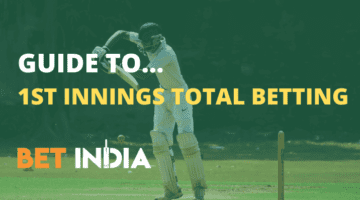Betting on Runs Markets in Cricket
Betting on the number of runs that will be scored over a certain period of time in a game of cricket- the first innings, the first six overs, a session in a Test match etc- has become extremely popular over the last few years.
If waiting until the match is over on the match winner market takes too long, or if trying to nail the right candidate on the top batsman, top bowler or man-of-the-match markets requires a little too much research and quite frankly, a fair bit of luck, then betting on runs is quicker and perhaps slightly less scientific.
This is precisely why betting on runs has become so popular, particularly in live betting.
So let’s go through the main types of runs markets in cricket, how they work and reveal some tips that will help you when you get round to playing them.
First Innings Runs Market
From an online betting perspective, this is by far the most popular of all the runs markets in India. In fact, more people tend to bet on this than they do on other popular markets like the toss.
Let’s break this down into the different elements involved in it so that you can become a pro at betting on the first innings total!
The par score
First up, let’s talk about the meaning of a par score. You can read our full guide to par scores in cricket but in a nutshell: a par score is the number of runs that a team is expected to score when batting first in a Test, ODI or T20 match.
As we explain in the article, it’s not an exact science. Two reasons.
One: different players taking part in the game, commentators, analysts and also cricket gamblers will have different opinions as to what is a par score on any given day.
For example, in a T20I match between India and Australia where India are batting first on a good track at Kolkata, Rohit Sharma may say he thinks 170 is par.
Commentator Ricky Ponting may think 160 is par, while data analyst Simon Hughes may say 180 is par and finally pro tipster Ed Hawkins has 175 as par.
The other issue is there are lots of factors that determine the par score, including: historical data for teams batting first at that ground, the wicket on that particular day, the strength of the two teams or the time of day the match is played. Some people will give more importance to one factor over another.
But after all this, let’s say the consensus is that 170 runs batting first is a par score, a view agreed with by betting site 10CRIC.
So how do we go about betting on it?
2-way Total Innings Runs Market
Now that they’ve established the par score, 10 CRIC are going to set an innings runs line, inviting gamblers to bet above or below the line.
The first thing to note is that they can’t make the line exactly 170.
Why? Well, because if India scored exactly 170 runs then the bet would be neither a winner nor a loser.
So instead, they’ll set the line at either 169.5 or 170.5. Given there’s no such thing as half a run in cricket and you can see that any first innings score will either be above or below that line.
It’s the same principle as in football where gamblers bet on whether there will be over or under 2.5 goals. Again, there’s no such thing as half a goal so it will always be over or under 2.5 goals.
So let’s say 10 CRIC makes the line 169.5 runs. Now it’s up to you to decide whether India will score below par, or above par.
Normally you’d expect to get odds of around 1.9 on one of the outcomes and about 1.85 or 1.9, on the other.
The 3-way Total Innings Runs Market
An alternative to the 2-way market (over or under) is the 3-way market. So rather than there being two outcomes, there are three.
For example:
- 163 or lower- odds of 2.6
- 164 to 180- Odds of 2.8
- 181 or over- Odds of 2.7
The advantage of betting on a 3-way market is that the odds on any of the three outcomes will be bigger than they were on the two-way market.
The disadvantage here is that you need to pick the right one from three selections, rather than two.
Ever-changing odds in Live Betting
The match winner market odds are constantly changing during the game on live betting.
Let’s say India started off at 1.7 and with Rohit Sharma and KL Rahul making an excellent start by scoring 20 off the first two overs, the bookies will have cut India to about 1.55.
A similar thing happens on the two-way innings runs market. But instead of cutting over 169.5 runs from 1.9 to 1.6, the bookies will re-adjust the line.
So after that fast start, they may make the line over/under 179.5 runs after two overs.
A similar thing would happen on the three-way innings runs market. As an example, the third option (where the most runs are scored) may have shifted from 181 or over (at 2.7) to over 191 at 2.7.
The following runs markets would be available for any Test match, T20 or ODI.
On some occasions the betting site may also offer a market on how many runs the team batting in the second innings might score, as well.
First Six/Ten overs Runs Total
For those who don’t want to wait till the whole innings is over, you can bet on how many runs will be scored after six overs (the Powerplay overs in a T20) or the first 10 overs (the Powerplay overs in an ODI).
The markets work exactly the same way as they do for the first innings runs market whether it’s a two-way market or a three-way one.
Bookmakers generally settle the market as soon as the first six or ten overs (in ODIs you may also have markets for the score at the 20 or 30-over mark) are over.
So if your bet lost, they’ll process it as a loss. If you just won, you’ll get paid out straight away rather than waiting for the end of the innings.
Betting Strategies
So that’s how the main innings runs markets work. But what are your best chances of beating the bookies?
The Early Gamble
Let’s say that 10CRIC offered the following odds on a three-way innings runs market:
- 163 or lower- odds of 2.6
- 164 to 180- Odds of 2.8
- 181 or over- Odds of 2.7
In your opinion, the par score looks too high. You think it’s a two-paced wicket and that the ball might move under lights.
You know that Rishabh Pant is missing and that Virat Kohli is somewhat out of form, so that’s one of India’s best players unavailable and another struggling for form.
So rather than wait a couple of overs to see if you were right about the wicket, now is the time to put your money down: before India start batting. And you put it on 163 or lower at 2.6.
If they lose an early wicket or are struggling for runs, that line may have moved to say 155 or lower so you may have missed your chance.
Of course the inverse is also true: if you think the par score looks too low it might be worth going with 181 or over at 2.7 before the innings gets underway.
Going Against the Grain
This is an alternative to the strategy just mentioned. In this case you deliberately wait for a live betting movement.
In this case let’s say 10 CRIC have priced up the two-way market as follows:
- Over 169.5- Odds of 1.9
- Under 169.5- Odds of 1.9
In this scenario, you’re pretty confident that India will get to 170. But you suspect it’s going to be pretty tight. So rather than take the pre-innings 1.9 on over 169.5 runs, you wait.
Sure enough, India make a slow start, losing KL Rahul and struggling to score boundaries. So after three overs, they’re 26/1 and that 170 is looking way off.
But now is the time to pounce. Because of the poor start, it’s now 1.9 that India will get over just 162.5 runs. In other words, you’re getting the same odds but the line has moved and it’s now considerably lower so easier for India to reach.
As long as you had good reasons for thinking they’d get to 170 in the first place- good batting line-up, a vulnerable bowler in the opposition’s side etc- then you’re getting a better deal now than you were at the start.
Though, of course, you also have to factor in that India lost a wicket and the run rate is low.
The trade
Cricket bettors who are used to using the online Betting Exchange Betfair will know all about trading on cricket. As an Exchange, it allows players to bet like a customer by backing odds but also to act like a bookmaker and lay odds. Or back both sides of the two-way market.
So for example, you could back India to win the match at 2.3 for ₹100 and then ten minutes later back Australia at 2.5 for ₹100. Because you bet the same stake at odds-against both times, you’re guaranteed a profit.
Sadly, Betfair isn’t available to Indian customers anymore. But you can execute a trade of sorts on a regular betting site that isn’t an Exchange. Same odds again, this time on Pure Win.
- 163 or lower- odds of 2.6
- 164 to 180- Odds of 2.8
- 181 or over- Odds of 2.7
Following the theory that the par score looks too high, you have a big bet for ₹10,000 on India to score 163 or lower. Sure enough, India are in trouble at 30-3 after just four overs.
So the line has moved and one of the options is to back 163 or higher at 2.6. So you do. It’s up to you how much you want to stake on your second bet. If you want to be conservative, you could make sure that if it’s 163 or higher you at least get all your money back.
You could level it up so your profit would be the same whether it went 163 or lower or 163 or higher. Or you could go the other way and leave most of your profit on India getting 163 or over.
As an added bonus, if India ended up on exactly 163, you’d actually win on both bets.
Other runs markets
The runs markets just described can also apply to individual batsmen. So rather than betting on the team’s total, you’re betting on how many runs a particular batsman will score.
As an example:
So just like with the team innings runs, you’ve got plenty of options in terms of how you go about things.
You could also apply the three betting strategies just mentioned to these markets.







